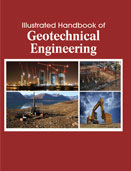Handbooks

Geotechnical engineering is an important field of engineering that is concerned with behavior of earth materials. Some of the important tasks of geotechnical engineering are designing of foundations for structures, embankments, storage systems for hazardous materials, and lessening soil erosion. This knowledge is applied to the design of foundations, retaining walls, earth dams, clay liners, and geosynthetics for waste containment. The goals of geotechnical engineers could range from the design of foundations and temporary excavation support, through route selection for railways and highways, to the increasingly important areas of landfill disposal of wastes and groundwater contamination. This handbook deals with the fundamentals and general principles of geotechnical engineering, this text also provides essential information related to the evaluation of engineering properties of soils, design of foundations such as spread footings, mat foundations, piles, and drilled shafts.
We live in the age of high tech. Though engineering stands at center stage becoming the key to survival, civil engineering is a much misunderstood and widely underestimated profession. It is a melancholy paradox: in its moment of ascendance and severely needed by society, civil engineering is frequently faced with the trivialization of its purpose and the debasement of its practice. Geotechnical engineering, however, is concerned with the mechanics of soil and rock and its applications to the development of humankind. Some of the important tasks of geotechnical engineering are designing of foundations for structures, embankments, storage systems for hazardous materials, and lessening soil erosion.
Illustrated Handbook of Geotechnical Engineering deals with the fundamentals and general principles of soil mechanics and geotechnical engineering, this text also examines the design methodology of shallow / deep foundations, including machine foundations. Geotechnical engineers are commonly engaged in the cleanup or remediation of sites that have been contaminated and represent a health to the environment. Geoenvironmental engineers use numerous techniques to remove the contaminants from the ground, many times, without even excavating the ground. Today geotechnical engineering has evolved and geosynthetics has helped to solve many conventional problems that are encountered by the engineers in the field. Geosynthetic products have a wide range of applications and are currently used in many civil and geotechnical engineering applications including roads, embankments, retaining structures, canals, landfills, bank protection, and coastal engineering. Geotechnology plays a key role in all civil engineering projects built on or in the ground, and it is vital for the assessment of natural hazards such as earthquakes, liquefaction, sinkholes, rock falls and landslides. Geotechnical engineering is also related to coastal and ocean engineering. Coastal engineering can involve the design and construction of wharves, marinas, and jetties. Ocean engineering can involve foundation and anchor systems for offshore structures such as oil platforms. The fields of geotechnical engineering and engineering geology are closely related, and have large areas of overlap. However, the field of geotechnical engineering is a specialty of engineering, where the field of engineering geology is a specialty of geology. Illustrated Handbook of Geotechnical Engineering provides critical background knowledge readers need to support any advanced study in design as well as to prepare them for professional practice. This Handbook will be of valuable for students and researchers involved in the field of Civil Engineering.